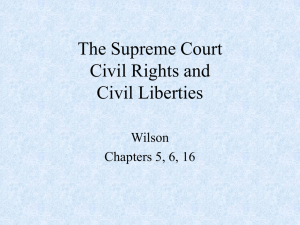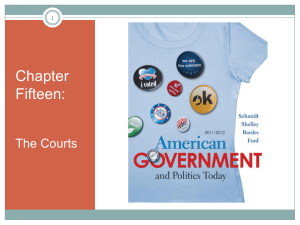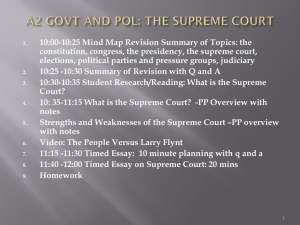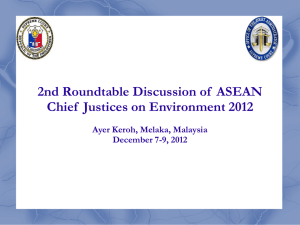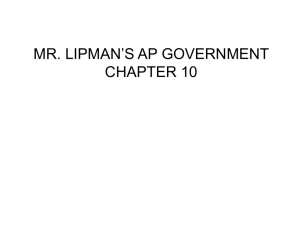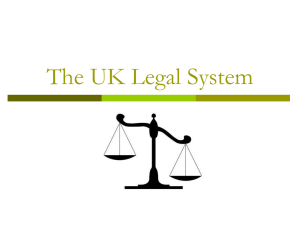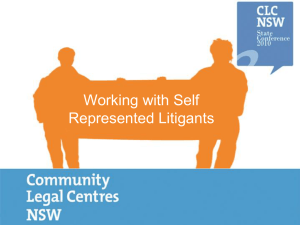Supreme Court
advertisement
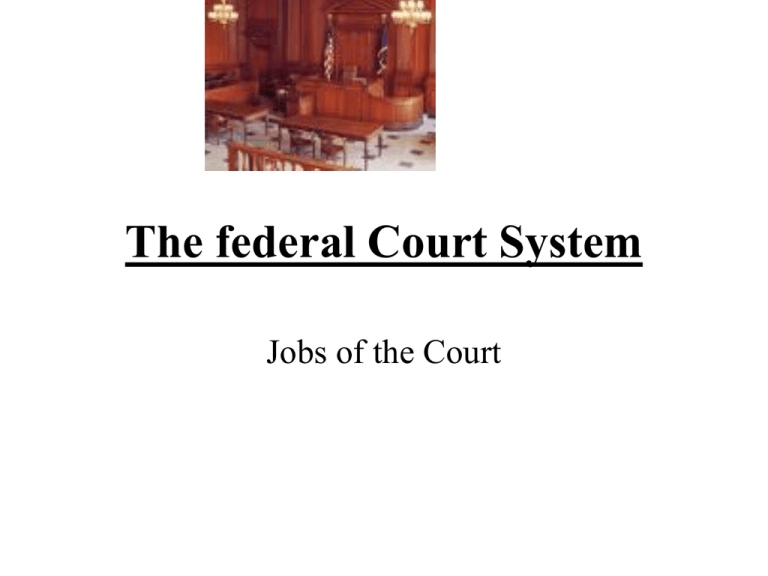
The federal Court System Jobs of the Court 1.Civil Disputes -Court settle disputes (arguments) • The court uses the law to make a decision • Cases deal with Money or taking away rights – Example-Roommate did not pay rent you want $$$ 2.Criminal cases- cases people are accused of breaking the law • Lawyers show evidence and Jury makes decision • Example- Stealing, Murder… 3.Accused people right to trial, lawyer • Can’t afford a lawyer court will give them one • Goal of courts is Equality under law Federal Court system Article III of the Constitution • Supreme Court highest court • congress make lower courts Three levels of Courts • 1.Lower district court- trial first • 2.appeals court middle- fight guilty decision I lower court • 3. Supreme Court • States have own courts Jurisdiction- which court has power over the case 1.law broken applies to US Constitution > Fed Court • example- A person is not allowed to speak at a rally sues for taking freedom of speech. 2 Cases involving Fed laws> Fed court • example- Somebody printing Fake money 3 Disagreement between state governments>Fed Court • example- Nevada sues California 4 Lawsuits citizens of different states > Fed Court • example- person from Texas sues a person from California over fake EBAY purchase 5 Someone sues US gov or US gov sues someone > Fed Court • example- Gov sued a company because they didn’t build jets the gov payed for. 6 Foreign governments between Us citizen or US government • example- A broken treaty 7 Accidents or crimes on oceans> Fed Court • example- Murder by an American on an American cruise line 8 Cases involving US diplomat> Fed Court • example- worker at the Mexican embassy is charged with murder. 2 Types of Jurisdiction • Exclusive- one court has power over case • Concurrent Jurisdiction- State and Fed Courts share power and control The Organization of Federal Courts • There are three levels of Federal Courts I. US District Courts (lowest level of courts) • • • • • -District courts are where trial (criminal) and Lawsuits (civil) start -Each state has minimum 1 district court -District courts have original jurisdiction (hear the case first time) -Hear both civil and Criminal cases -Only court that involve witnesses & juries II. US Courts of Appeals • -Lose in district court appeal next level • (Once proven innocent there is no appeal) • -Appeals court- jurisdiction to review decision of lower court • -There are 12 US courts of Appeals covers an area on US map (circuits) Trial Judges review cases and listen to lawyers do not decide guilt or innocence • • • • • -Decide if original trial was fair and protected rights -Uphold original decision -Reverse the original decision -Remand the case- send it back to a lower court -Most cases end at appeals court some make it to the Supreme Court III Supreme Court Cover later Federal Judges • • • -Each district has minimum 2 judges -Each Appeals court has 6-27 judges -Supreme Court has 9 Justices • • President appoints judgessenate approves them -Judges serve for Life -Judges can be impeached and removed Job of Judge • -Hear preliminary evidence • -Determine whether case goes to trial • -Decides if accused jailed or released on bail US Attorneys- government lawyer prosecutes people accused -Defend the government when they are being sued US Marshals-(US Police) • -Collect evidence/ arrest people/ take the convicted to prison/ protect witnesses THE US SUPREME COURT I. The Supreme Court Justices • -Main job us Sup Court decide whether laws are Constitutional -allowed by constitution • Cases arrive to Supreme Court from appeal Court • -Cases involving State & Foreign Diplomats straight to Sup Crt • -Sup Crt chooses what cases to listen too • -Decision of Crt is Final The justices • • -There are 8 justices and 1 Chief Justice -Give a written explanation of all decision • -Each judge gets 1 vote of decision • -President chooses Justice, senate approves • -To be chosen-Lawyer, Great career, agree ideas of President II Powers of the Court • -Legislative (congress ) and Executive (president ) branches must follow court decision • -Court has Judicial Review-Power to say if law or Gov actions are constitutional 3 principals of Judicial Review • 1.constitution supreme Law • 2.IF law goes against Constitution, constitution wins • 3.Judicial Branch duty support Constitution Judicial review controls power of Executive and Legislative Branch (Example Prop 187 passed in CA 1994) • -Law Stated NO illegal immigrant can getEducation or Healthcare by gov • -Supreme court said law was unconstitutional-Gov can not deny education or healthcare to anybody III Limits on the Courts Power • Supreme court cannot enforce laws • Executive Branch, States, Local Gov enforce laws with- military, state police, city police • Congress can make new laws that change constitution • -Congress can vote to impeach a Justice • -Laws must be challenged in lower District courts before Supreme Court can decide it’s unconstitutional. Deciding Cases at the Supreme Court • I. How Cases Reach the Court. • -Court runs from October – July • -Each month’s justices listen cases for 2 weeks& 2 weeks writing opinions • -Supreme courts gets cases from Appeals court • -7000 cases apply to be heard by Supreme Court per year • • -Justices agree to hear less than 200 - 4 of nine justices must agree to hear cases • -Choose cases involving constitutional issues • -All accepted cases are put on docket- calendar II. Steps in Decision Making The 5 steps • 1. Lawyer make written explanation of their side-Brief • 2. Each sides lawyers gets 30 minutes to talk about their case • 3.Court makes a decision (1 vote per justice) One justice writes a majority opinion- why they made the decision 4. Those who disagree with majority- write dissenting opinion- why they disagree with other justices 5. Court announces the decision- gives copies to news, post on website IF ALL JUSTICES AGREE-UNANIMOUSE DECISION III. Reasons for court Decision • • • • • 1. Law is most important influence on decision 2. Justices consider what Constitution says a. Look back at older decision 3. Laws must be flexible to change with times 1800’s segregation based on color was legaltoday that is illegal.



